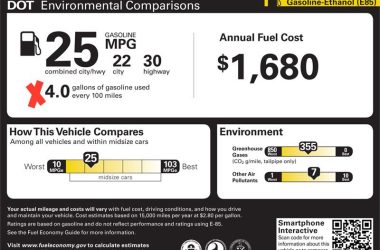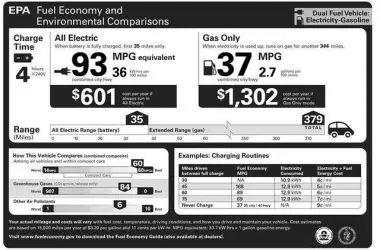What is Cargo Space?
Cargo space refers to the area of a vehicle that is designed to hold items being transported. It is measured in cubic feet or liters and represents the total volume available for carrying cargo. Cargo space may be found in the trunk or cargo area of cars, SUVs, vans, trucks, trailers, and other vehicles used to transport goods and materials.
The cargo space allows you to load items that won’t fit inside the main cabin of the vehicle. The size and shape of the cargo area can vary greatly depending on the vehicle. For example, sedans have trunks that offer a cubic feet or two of capacity, while large vans and trucks may have over 100 cubic feet of cargo space. Vehicles optimized for cargo, like pickups and cargo vans, tend to have the most voluminous cargo holds.
Cargo space is distinct from passenger space, which refers to the area occupied by seats for passengers. Vehicles are often described based on a mix of passenger capacity and cargo capacity. For instance, a minivan may seat 7 passengers and offer massive amounts of cargo space behind the rear seats. Customer vehicles like SUVs balance passenger and cargo room in the back.
The cargo space allows you to customize your vehicle for the job at hand. With the rear seats folded down, an SUV can haul building materials and furniture. A pickup truck bed gives you a large open cargo area for equipment and supplies. Cargo vans offer cavernous cargo bays for commercial delivery purposes. In each case, cargo space gives you flexibility in how you use your vehicle.
Measuring Cargo Volume
The volume of cargo space is typically measured in cubic feet or cubic meters. The basic formula for calculating cargo volume is length x width x height.
For example, if a vehicle’s cargo area is 5 feet long by 4 feet wide by 3 feet high, the volume would be 5 x 4 x 3 = 60 cubic feet. In metric units, with dimensions of 1.5 meters x 1.2 meters x 0.9 meters, the volume would be 1.5 x 1.2 x 0.9 = 1.62 cubic meters.
Some key things to know when measuring cargo volume:
- Measure the length, width and height internally, accounting for any protrusions or irregular shapes.
- For non-cuboid spaces, calculate the volume of each individual shape then add them together.
- Account for wheel wells or spare tires when measuring SUVs or vans.
- Use cubic inches for very small spaces. There are 1728 cubic inches in 1 cubic foot.
Understanding how to accurately measure cargo capacity allows you to determine how much you can transport and if a vehicle has enough space for your needs.
To maximize utilization, look at both volume and weight capacity and how to pack the space efficiently. Cargo volume is a key specification to consider when shopping for cars, trucks or vans. Proper measurement helps ensure you select a vehicle that meets your cargo requirements.
(Info cited from: https://m.facebook.com/KnowExportIMport/photos/1223226394552734/?locale=ms_MY)
Cargo Weight Capacity
Payload capacity refers to the maximum weight a vehicle can carry, including cargo, passengers, and fuel. It’s calculated by subtracting the curb weight (weight of the vehicle with standard equipment and a full tank of fuel) from the gross vehicle weight rating (GVWR).
The GVWR is the maximum allowable total weight of a vehicle when loaded, including all cargo and passengers. Vehicle manufacturers determine the GVWR by considering the vehicle’s design specifications, including engine power, braking capacity, axle ratings, and suspension limits.
Exceeding the GVWR or payload capacity can put strain on various vehicle components and affect vehicle handling and braking. Overloading increases the risk of premature wear, component failures, and accidents.
Truck buyers should pay close attention to payload ratings when configuring their vehicle. Factors like cab size, bed length, and drive type can all impact payload. Upgrades like larger wheels or premium interiors may look nice but also add weight and reduce capacity.
There are resources like this Firestone article that provide more details on truck payload capacities and weight limits.
Cargo Space in Cars
When looking at cargo space in cars, there are some key differences between hatchbacks and sedans. Hatchbacks tend to offer more cargo space and versatility since the rear seats can fold down and there’s a large rear door for loading items. Sedans have a trunk which is accessed through the trunk lid, and rear seats usually can’t fold down, so cargo space is more limited.
According to Consumer Reports[1], some sedans with the most cargo space behind the rear seats are the Toyota Avalon (16 cubic feet), Chevrolet Impala (18.8 cubic feet), and Hyundai Azera (16.6 cubic feet). The Honda Civic hatchback offers 25.7 cubic feet behind the rear seats.
To maximize cargo space in cars, most hatchbacks and some sedans offer 60/40 split-folding rear seats. This allows part or all of the rear seats to fold down, opening up more interior cargo room. For example, with the rear seats folded, the Volkswagen Golf hatchback offers 52.7 cubic feet of cargo room, much greater than what its trunk could normally hold.
Cargo Space in SUVs
SUVs offer generous cargo space and flexibility due to their increased size and utility compared to sedans. One key feature for maximizing cargo capacity is fold-flat rear seats. Most midsize and larger SUVs have a 60/40 split-folding 2nd row seat allowing part or all of the seat to fold down for expanded cargo room. Many 3-row SUVs also have a 50/50 split 3rd row seat that can fold flat into the floor to create a large storage area when needed.
According to Source 1, popular midsize SUVs like the Toyota Highlander and Honda Pilot offer over 80 cubic feet of cargo space with both rear rows folded. Full-size SUVs like the Chevy Tahoe provide nearly 95 cubic feet of maximum cargo room. This allows SUVs to carry large, bulky items like furniture or outdoor gear.
Another useful cargo feature on many SUVs is roof racks. Roof racks provide additional storage space for hauling oversize items like skis, kayaks, or cargo boxes. The roof rack crossbars can support hundreds of pounds depending on the vehicle. Owners should consult their owner’s manual for weight limits to avoid overloading the roof.
Cargo Space in Vans
Vans offer a significant amount of cargo space and versatile interior dimensions for transporting tools, equipment, and large items. Most cargo vans have a regular roof height of 55-65 inches, but high roof options around 76 inches allow you to haul taller objects.
The most common cargo van rental from Enterprise has up to 270 cubic feet of empty cargo space with interior dimensions of 155 inches long by 93 inches wide by 76 inches high (Enterprise). Other key measurements for empty cargo vans:
- Length ranges from ~190-270 inches
- Width ranges from ~72-93 inches
- Height ranges from ~55-76 inches
With no shelving, partitions or equipment fitted inside, you can maximize the use of every inch. Large items like appliances and furniture can often be transported by cargo van.
Cargo Space in Trucks
Trucks come in a wide variety of sizes and configurations to accommodate different cargo hauling needs. The most basic distinction in truck cargo beds is between short bed and long bed models.
Short bed trucks, sometimes called standard bed, typically have a cargo bed length between 5.5 and 6.5 feet. Popular short bed truck models include the Ford F-150, Chevy Silverado 1500, and Toyota Tacoma.
Long bed trucks have cargo beds over 8 feet long, usually around 8.5-9 feet. Long beds provide much greater cargo capacity than short beds but can be more difficult to maneuver and park. Common long bed trucks are the Ford F-250, Ram 2500, and Nissan Titan XD. According to Pinterest the most common pickup truck bed lengths are:
- Short bed: 5’5″ – 6’5″
- Standard bed: 6’5″ – 8′
- Long bed: 8′ – 9′
In addition to bed length, an important factor for hauling heavy cargo is payload capacity and towing capacity. Payload refers to the maximum weight a truck can carry in its bed. Towing capacity is the max weight a truck can safely pull in a trailer.
Heavy duty pickup trucks like the Ford F-350, Chevy Silverado 3500, and Ram 3500 often have payloads over 5,000 lbs and towing capacity over 15,000 lbs. Lighter duty trucks like the Honda Ridgeline or Nissan Frontier have payloads around 1,500 lbs and towing capacity under 7,000 lbs. Checking the specs of a specific truck model is important for determining how much cargo it can safely transport.
Maximizing Cargo Capacity
There are various tips and tricks to maximize the cargo capacity of your vehicle. Careful packing and loading can help optimize the available space. Here are some packing tips:
- Prioritize the largest and heaviest items closest to the rear.
- Pack items tightly with no gaps.
- Use space-efficient storage containers.
- Load taller items in the center and lower items on the sides.
- Secure items with tie-downs or cargo nets to prevent shifting.
- Consider a roof cargo box or basket for additional space.
You can also modify your vehicle to increase cargo capacity:
- Add a trailer hitch and hitch-mounted cargo rack.
- Install a roof rack system.
- Upgrade to a higher capacity suspension.
- Remove rear seats if not needed.
With some clever packing and a few modifications, you can maximize every inch of cargo space your vehicle has to offer.
Cargo Space and Fuel Efficiency
The amount of cargo space a vehicle has can impact its fuel efficiency and aerodynamics. Vehicles with a lot of open cargo area create more drag and reduce aerodynamics, which decreases fuel economy. Large, boxy cargo vans and trucks often have poor fuel efficiency for this reason.
Additionally, carrying heavy cargo loads adds weight to the vehicle, which also reduces fuel efficiency. Each extra 100 lbs of weight can decrease MPG by up to 2%, depending on the vehicle. So maximizing cargo space but keeping cargo weight down can help optimize MPG.
Some tips for balancing cargo capacity and fuel efficiency include:
- Choosing smaller, more aerodynamic vehicles like CUVs or hatchbacks rather than larger vans or trucks.
- Using cargo organizers, storage bins, and tie downs to minimize open empty space.
- Travelling light when possible and removing unneeded items from cargo area.
- Looking for low, flat storage areas rather than large upright cargo spaces.
- Opting for folding/removable seats to customize cargo and passenger space as needed.
With some planning, it’s possible to find vehicles that offer both generous cargo room and decent MPG ratings. Prioritizing fuel-efficient models and packing carefully can help maximize both cargo capacity and fuel economy.
Cargo Management Systems
To make the most of your vehicle’s cargo space, using cargo management systems can help keep items organized, secured, and accessible. Here are some key cargo management tools and tips:
Racks, Bins, and Drawers
Installing a rack system with adjustable tie-down points allows you to secure items of various shapes and sizes. Storage bins and drawers can also be installed to compartmentalize the cargo area, keeping like items together while preventing them from shifting around.
Securing Cargo
Use tie-downs, nets, straps, and anchors to secure cargo and prevent it from sliding. Tie heavier items down or place them lower in the cargo area. Use non-slip mats or surfaces to help lighter items stay in place. Take advantage of attachment points and tracks pre-installed in the cargo area. Make sure to distribute weight evenly and avoid overloading one area.
Properly securing cargo helps prevent damage, makes items easier to access, and improves safety by preventing load shift.





